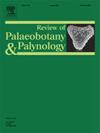弹性裸子植物:重新评估梅山二叠纪-三叠纪物种灭绝的花卉动态
IF 1.7
3区 地球科学
Q2 PALEONTOLOGY
引用次数: 0
摘要
二叠纪-三叠纪大灭绝对陆生植物多样性和生态系统的影响仍存在争议。虽然对于许多植物化石记录,特别是来自陆地遗址的植物化石记录,不可能进行适当的定年,但对于沉积在海洋环境中的植物微化石记录,通常可以进行独立的生物地层定年。自从眉山二叠纪-三叠纪界线的全球层型剖面和点(GSSP)被批准以来,不仅有大量的孢粉学数据,而且有精确的年代学年龄,高分辨率的地球化学和生物地层数据集。在此,我们拟对欧阳等人发表的孢粉学资料进行修订。在目前的地质年代学框架下是在1990年。他们最初描述的三个组合带提供了关于沉积环境和植被组成的丰富信息——从沿海的二叠纪环境到更近的三叠纪环境。迄今为止,将孢粉学资料与碳同位素记录、当前岩石地层和U/Pb年龄进行比较,表明梅山附近大陆地区在二叠纪-三叠纪灭绝事件期间和之后,裸子植物为主的植被繁盛。本文章由计算机程序翻译,如有差异,请以英文原文为准。
Resilient gymnosperms: reassessing floral dynamics at the permian–triassic extinction in Meishan
The impact of the Permian–Triassic mass extinction on terrestrial plant diversity and ecosystems is still controversially discussed. While for numerous plant fossil records, particularly those from terrestrial sites, adequate dating is unfeasible, for plant microfossil records, deposited in marine environments, independent biostratigraphic dating is usually possible. Since the ratification of the Global Stratotype Section and Point (GSSP) for the Permian–Triassic boundary in Meishan, a plethora of not only palynological data but also precise geochronological ages, high-resolution geochemical and biostratigraphic datasets are available. Here, we aim to revise the palynological data published by Ouyang & Utting in 1990 in the current geochronological framework. Their three initially described assemblage zones yield a wealth of information with respect to depositional environment and vegetation composition- from an off-shore Permian setting to a more proximal setting in the Triassic. To date, the comparison of the palynological data with the carbon isotope record, current lithostratigraphy, and U/Pb ages indicates that gymnosperm-dominated vegetation thrived during and after the Permian–Triassic extinction event in the continental area near Meishan.
求助全文
通过发布文献求助,成功后即可免费获取论文全文。
去求助
来源期刊
CiteScore
3.50
自引率
21.10%
发文量
149
审稿时长
6 months
期刊介绍:
The Review of Palaeobotany and Palynology is an international journal for articles in all fields of palaeobotany and palynology dealing with all groups, ranging from marine palynomorphs to higher land plants. Original contributions and comprehensive review papers should appeal to an international audience. Typical topics include but are not restricted to systematics, evolution, palaeobiology, palaeoecology, biostratigraphy, biochronology, palaeoclimatology, paleogeography, taphonomy, palaeoenvironmental reconstructions, vegetation history, and practical applications of palaeobotany and palynology, e.g. in coal and petroleum geology and archaeology. The journal especially encourages the publication of articles in which palaeobotany and palynology are applied for solving fundamental geological and biological problems as well as innovative and interdisciplinary approaches.

 求助内容:
求助内容: 应助结果提醒方式:
应助结果提醒方式:


